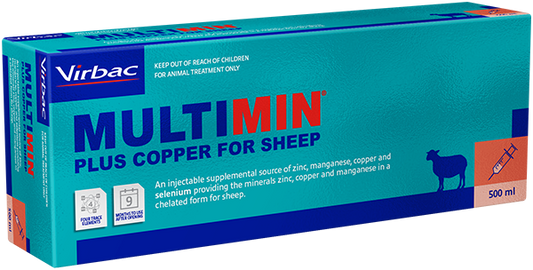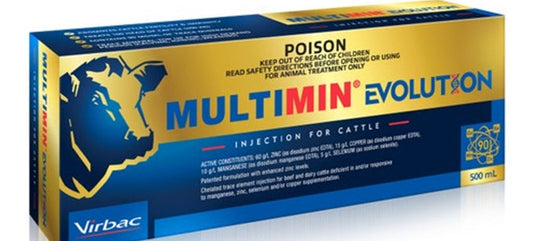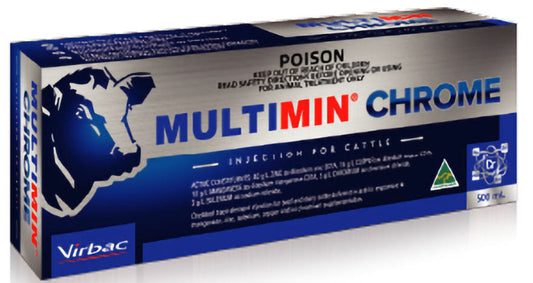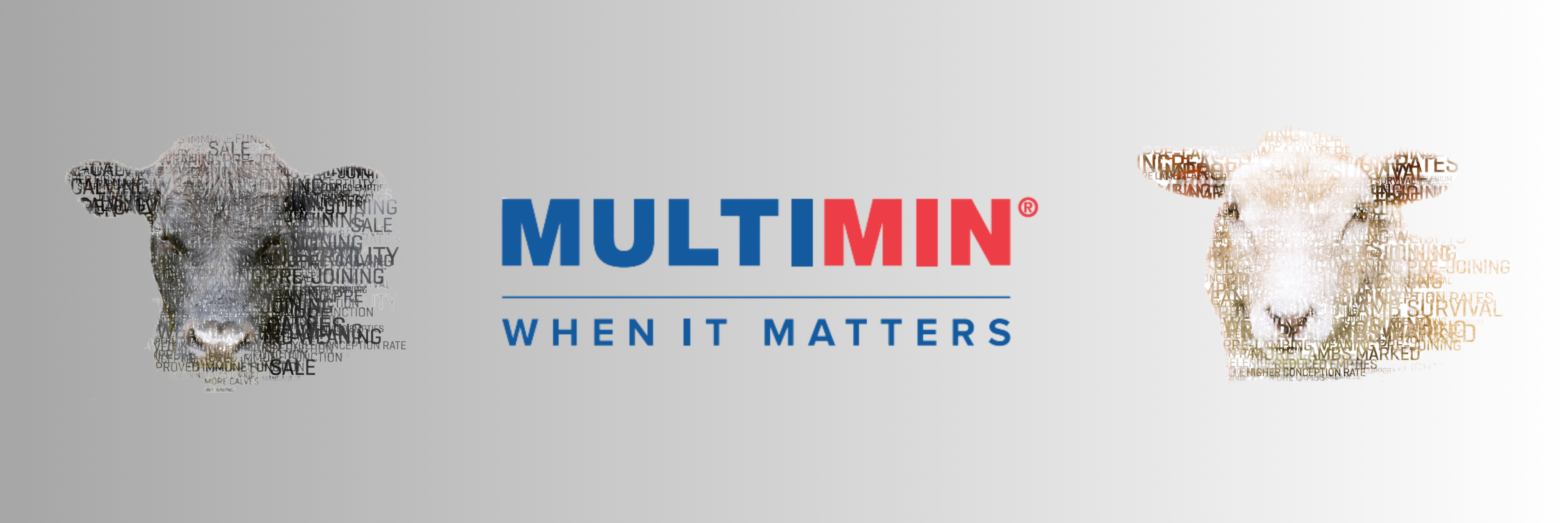
Multimin - Cattle
-

To perform well, cattle need optimal levels of energy, protein, vitamins and minerals. Cattle can readily turn fibrous feed and plant material into energy, protein and vitamins. However, cattle cannot easily absorb and utilise trace minerals from feed during high demand periods when the demand for trace minerals increases.^1
Oral trace minerals alone are unlikely to meet the requirements during these high demand periods. Multimin® Evolution Injection for Cattle is a unique trace mineral injection containing copper, selenium, zinc and manganese that increases productivity by improving fertility and immunity when it matters most.
-

Multimin Evolution is rapidly absorbed, readily utilised and provides sustained antioxidant activity during high demand periods such as calving, mating, weaning and dry off in dairy cows.
Multimin Evolution contains the highest trace mineral content (90 mg/mL) of any other injectable trace mineral product on the market in a low volume formulation that is rapidly absorbed, readily utilised and provides sustained antioxidant activity during high demand periods.^2, 4, 42
Multimin Evolution has 50% more Zinc than any other injectable trace mineral product on the market. Zinc is critical for reproduction, immunity and to meet the high demands of modern cattle.
-

Multimin Evolution should be administered prior to ‘high demand’ periods of cattle such as four weeks before calving in heifers and cows, eight to four weeks before artificial insemination or joining, and at weaning in calves, to allow antioxidant levels to peak.^5
For best results, Multimin Evolution can be administered every 3 months according to your management practices, and the trace mineral requirements of your animals. Multimin Evolution can be used regardless of seasonal conditions and as part of an integrated nutrition and animal health program.
Always administer in a different injection site to other injectables. DO NOT use concurrently with drenches, boluses or other animal health products containing selenium or copper.
-

Multimin Evolution has been shown to improve first cycle
conception rates by up to 19.4%^6-8. Pregnancy rates in breeding females treated with Multimin Evolution are up to 12% higher than untreated females, depending on the length of the breeding season and breeding method.^6,7,9-11Bulls treated with Multimin Evolution 90 days prior to joining had a 22% higher sperm concentration and significantly more motile sperm than control animals.^12-15
Multimin Evolution improves cow and calf health and speeds up vaccine response.^8,24,33-41
Collapsible content
CATTLE REFERENCES
1. Suttle, N. (2010). Mineral Nutrition of Livestock, 4th
Edition. CABI, Cambridge.
2. Hansen (2010) Effects of Multimin®90 on trace mineral
status of Angus and Simmental calves. Iowa State University, Department of
Animal Science.
4. Pogge, D. J. et al. (2012). Mineral concentrations of
plasma and liver after injection with a trace mineral complex differ among
Angus and Simmental cattle. J. Anim. Sc. 90(8), 2692-2698.
5. Refer to registered label APVMA n 87739. 6. Mundell, L.
et al. (2012). Effects of prepartum and postpartum bolus injections of trace
minerals on performance of beef cows and calves grazing native range, Prof.
Anim. Sci., 28:82- 88. 7. Virbac (2015) Trial protocol 578/15*.
8. Virbac (2018) Trial protocol 594/18*.
9. Sales, J. et al.
(2011). Effect of injectable copper, selenium, zinc and manganese on the
pregnancy rate of crossbred heifers (Bos indicus x Bos taurus) synchronised for
timed embryo transfer. Livest. Sci., 142:59-62.
10. Hawkins D. (2007). The effect of injectable trace
elements (Multimin®) on health and reproduction parameters in NZ dairy herds,
NZ Dairy Cattle Veterinarians Newsletter, 24(3):12-16*.
11. Mitchell. K. et al. (2008). Injectable trace elements
increase reproduction efficiency in dairy cows, in Trace Elements in Animal
Production Systems, 296-299.
12. Durel et al. (2016), proceedings of the 29th World
Buiatrics Congress, Dublin, Ireland, 3-8 July 2016*.
13. Hill S.L et al (2015). Breeding soundness of weaned bull
calves treated with bolus injections of trace minerals. Proceedings of the
Society for Theriogenology Annual Conference, San Antonio, TX, USA - Aug. 5 -
9, 2015.
14. Preedy, G. W. et al. (2018). Injectable trace-mineral
supplementation improves sperm motility and morphology of young beef bulls.
Prof. Anim. Sci., 34(1), 1-9.
15. Sullivan, L.T. et al. (2018) Evaluation of essential oil
and injectable trace mineral on bull growth performance and fertility, Transl.
Anim. Sci., Volume 2, Issue suppl_1, S189–S192.
21. Yatoo, M. I., et al (2013). Role of trace elements in
animals: a review. Vet. World, 6(12), 963-967.
24. Palomares, R. et al. (2016). Effects of injectable trace
minerals on humoral and cell-mediated immune responses to Bovine Viral Diarrhea
Virus, Bovine Herpes Virus 1 and Bovine Respiratory Syncytial Virus following
administration of a modified-live virus vaccine in dairy calves. Vet. Immunol.
Immunopathol., 178:88-98.
33. Richeson, J. et al. (2006). Supplemental trace minerals
from injection for shipping-stressed cattle. AAES Research Series, 574: 85-88*.
34. Hoyos-Jaramillo
A., et al. (2019) Health status and endoscopic evaluation of the upper
respiratory tract of dairy bull calves inoculated with BVDV2 and BHV1 after
vaccination and trace minerals injection. Proc.
35. Steeve Giguère Science of Veterinary Medicine Symposium
October 10, 2019 University of Georgia. 35 Arthington, J. et al. (2014).
Effects of trace minerals on measures of performance and trace mineral status
of pre- and post-weaned beef calves. Journal Animal Science, 92:2630-2640.
36. Arthington, J. D., & Havenga, L. J. (2012). Effect
of injectable trace minerals on the humoral immune response to multivalent
vaccine administration in beef calves. J. Anim. Sci., 90(6), 1966-1971.
37. Roberts, S. L. et al (2016). Effect of injectable trace
mineral administration on health, performance, and vaccine response of newly
received feedlot cattle. Prof. Anim. Sci., 32(6), 842-848.
38. Ball, M. (2016). Trace mineral injection enhances
antibody response to botulism vaccination. AVA Proceedings, Adelaide*.
39. Bittar, J. H. et al (2020). Immune response and onset of
protection from Bovine viral diarrhea virus 2 infection induced by
modified-live virus vaccination concurrent with injectable trace minerals
administration in newly received beef calves. Vet. Immunol. Immunopathol,
110055.
40. Bittar, J. H. J. et al (2018). Effects of injectable
trace minerals administered concurrently with a modified live virus vaccine on
long-term protection against bovine viral diarrhea virus acute infection in
dairy calves. Res. Vet. Sci., 119, 250-258.
CVS Online Vet, Pet & Farm Supplies
MULTIMIN EVOLUTION FOR CATTLE
Share
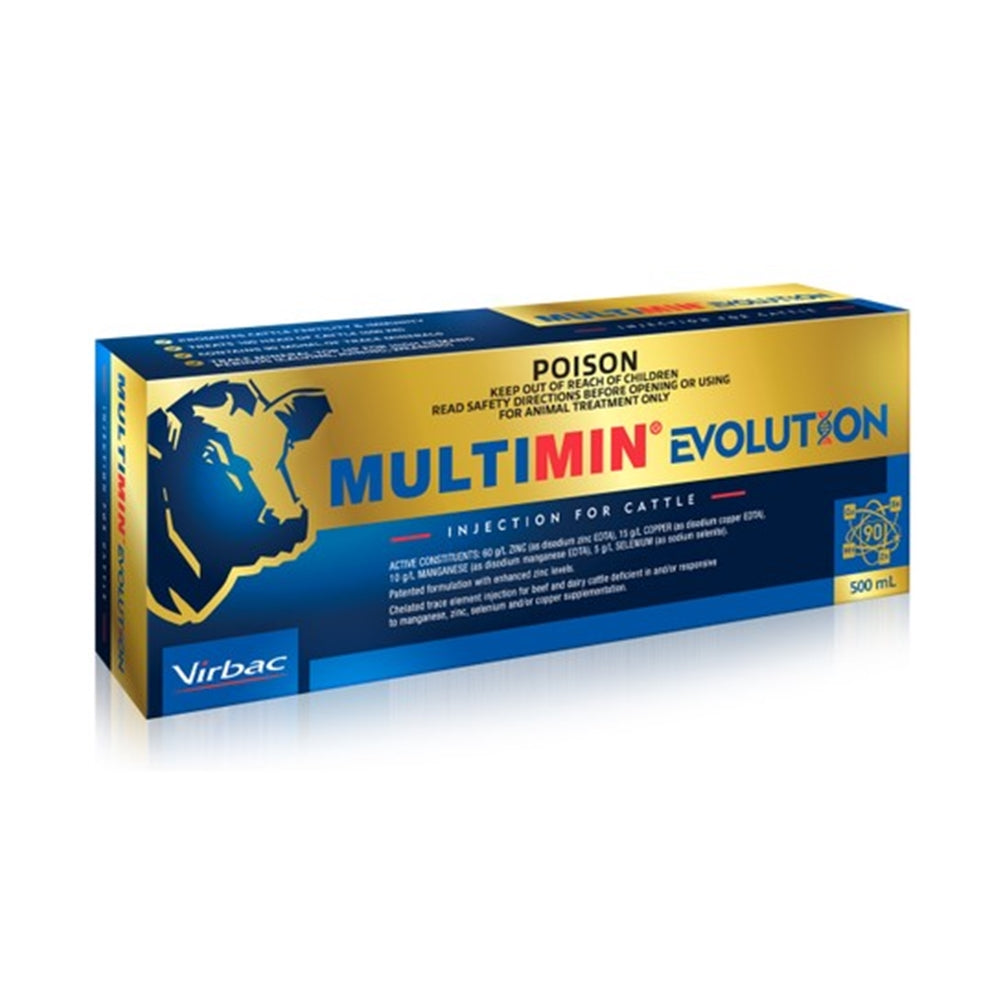
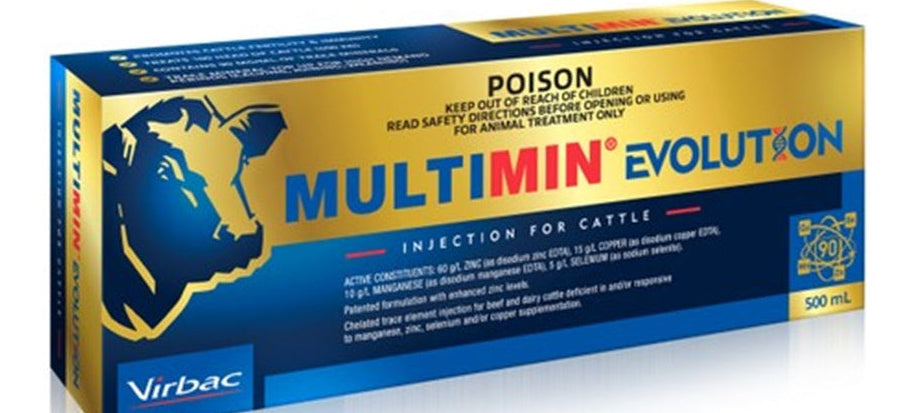
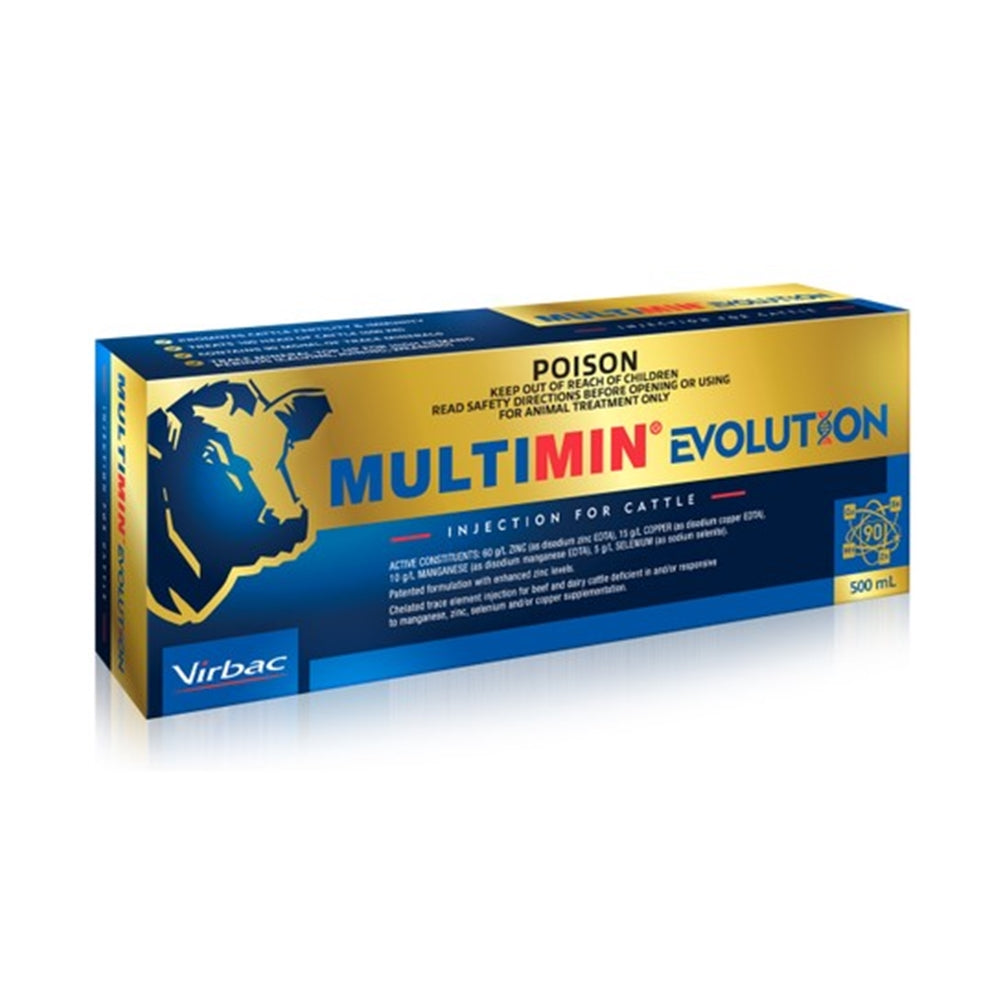
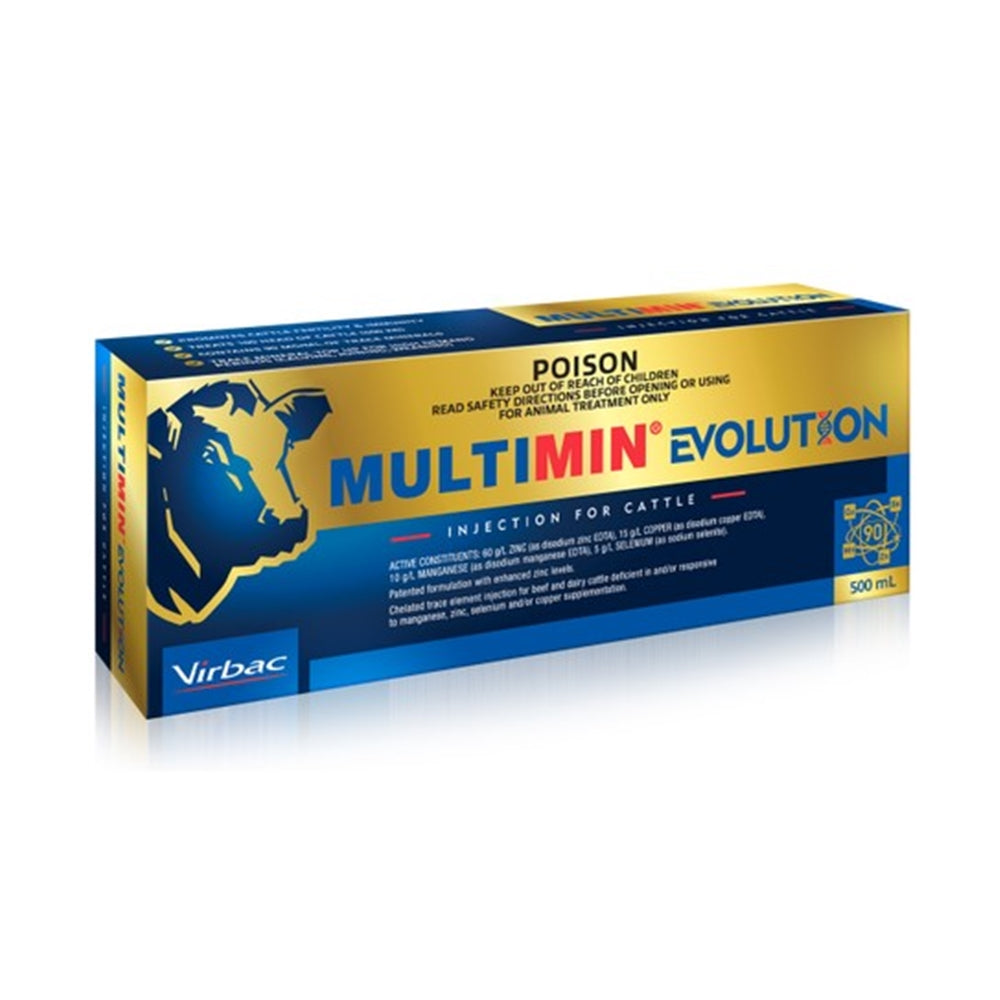
Multimin - Sheep
-

- Multimin Plus Copper Injection for Sheep: For sheep with elevated copper needs.
- Multimin Copper-Free Injection for Sheep & Cattle: For sheep with high or unknown copper levels.
-

There are a number of fertility and productive benefits when using Multimin. Some include:
- Optimises lambing and fertility — improves conception rates, embryo survival, sperm quality, and lamb survival.
- Improves immune function — supports disease resistance and boosts vaccine response.
- Multimin improves lamb health and weaning weights.
-

Multimin provides trace minerals — zinc, manganese, selenium, and copper — essential for antioxidant production and optimal mineral balance.
Antioxidants support:
- Neutralization of harmful free radicals.
- Prevents oxidative stress that can damage cells and reduce fertility.
Optimal mineral balance supports:
- Growth and productivity
- Immune function
- Fertility and pregnancy outcomes
-

Before high demand periods administer 0.2 mL per 10 kg bodyweight (1 mL per 50 kg) subcutaneously to your sheep.
Multmin's is recommended to be given to ewes one month before joining and rams three months before joining for best fertility results.
There is no withholding period for meat, milk, or export.
It is important not to mix Multimin in the same syringe or use concurrently with other copper/selenium products.
Collapsible content
SHEEP REFERENCES
Multimin - Sheep REFERENCES:
1. Swaney, S. (2014). Increasing conception rates in sheep by using an injectable trace mineral product prior to joining in diverse regions across Australia, Virbac data on file. ▲Multimin
Copper-free injection for sheep and cattle was used in this trial (APVMA n
61724).
2. Gonzalez-Rivas P.A., Swaney S., Evans R., Chambers M., Liu J. (2021) Effect of a trace mineral injection before joining and lambing on conception rate, marking rate and lamb weights in diverse farms in Victoria. Animal Production in Australia 33, cxxviii.
3. Refer to registered labels APVMA n 61724 and 83674.
4. Ghorbani, A. et al. (2018). Influences of dietary selenium, zinc and their combination on semen characteristics and testosterone concentration in mature rams during breeding season, J. Appl. Anim. Res.46(1):813-819.
5. Piagentini, M. (2017). Effect of selenium supplementation on semen characteristics of Brazil’s ram. Reprod. Domest. Anim. 52(3). 355-358.
6. Masters, D.G. et al. (1988). Influence of manganese intake on body, wool and testicular growth of young rams and on the concentration of manganese and the activity of manganese enzymes in tissues. Aust. J. Agri. Res. 39:517–524.
7. Underwood, E.J. and Somers, M. (1969). Studies of zinc nutrition in sheep. 1. The relation of zinc to growth, testicular development and spermatogenesis in young rams. Aust. J. Agri. Res. 20: 889–897.
19. Arthington, J. D., & Havenga, L. J. (2012). Effect of injectable trace minerals on the humoral immune response to multivalent vaccine administration in beef calves. J. Anim. Sci., 90(6), 1966-1971*.
20. Roberts, S. L. et al (2016). Effect of injectable trace mineral administration on health, performance, and vaccine response of newly received feedlot cattle. Prof. Anim. Sci., 32(6), 842-848*.
21. Palomares, R. et al. (2016). Effects of injectable trace minerals on humoral and cell-mediated immune responses to Bovine Viral Diarrhea Virus, Bovine Herpes Virus 1 and Bovine Respiratory Syncytial Virus following administration of a modified-live virus vaccine in dairy calves. Vet. Immunol. Immunopathol., 178:88-98*.
22. Ball, M. (2016). Trace mineral injection enhances antibody response to botulism vaccination. AVA Proceedings, Adelaide*.
23. Hansen, S (2010) Effects of Multimin®90 on trace mineral status of Angus and Simmental calves. Iowa State University, Department of
Animal Science*.
24. Pogge, D. J. et al. (2012). Mineral concentrations of plasma and liver after injection with a trace mineral complex differ among Angus and Simmental cattle. J. Anim. Sc. 90(8), 2692-2698*.
25. Virbac (2020) Trial protocol 616/20*. MKTGLST072
CVS Online Vet, Pet & Farm Supplies
MULTIMIN PLUS COPPER INJECTION FOR SHEEP 500ML
Share
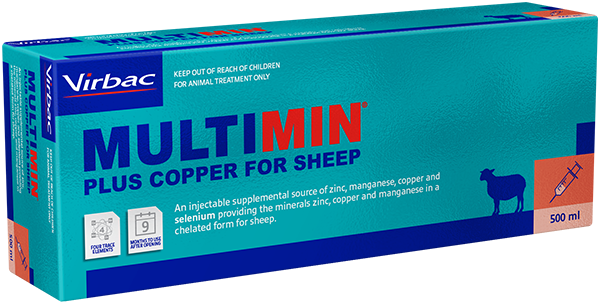
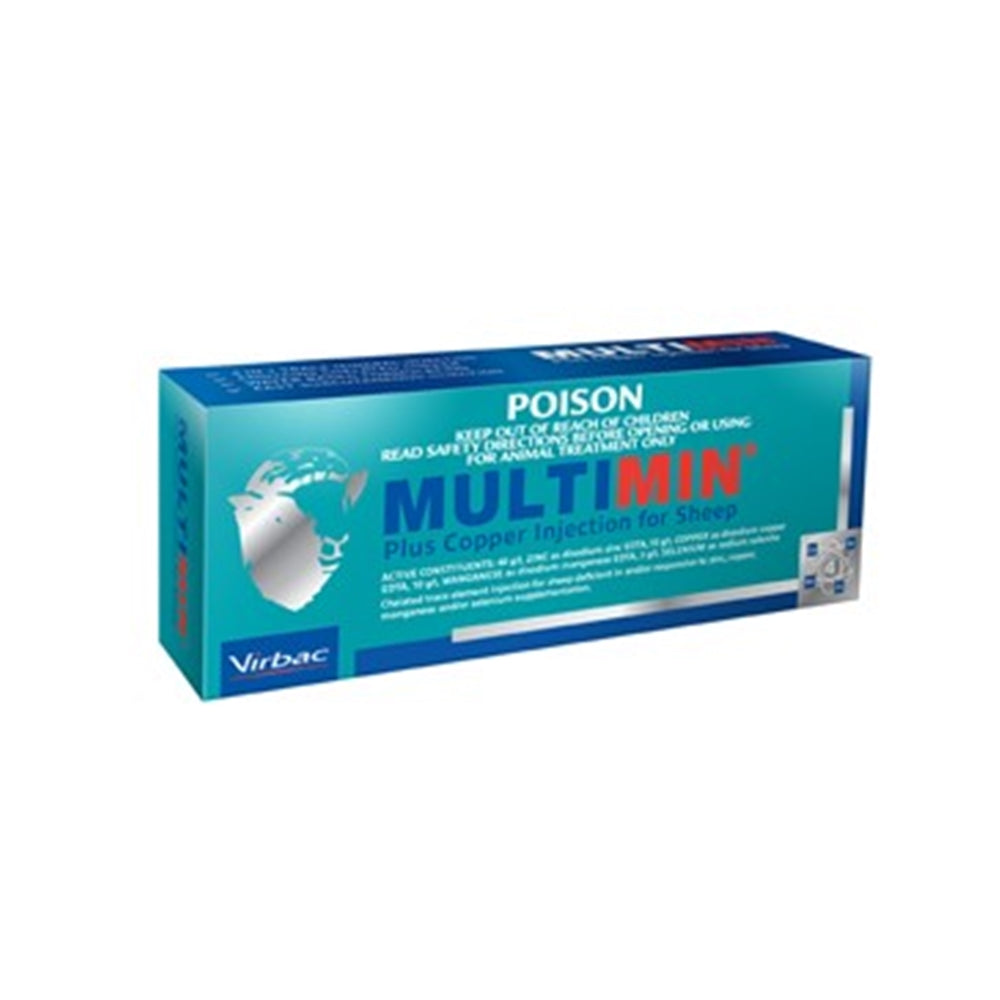
Discover our range of Multimin Products:
-
MULTIMIN PLUS COPPER INJECTION FOR SHEEP 500ML
Regular price $608.75 AUDRegular price -
MULTIMIN EVOLUTION FOR CATTLE
Regular price From $270.50 AUDRegular price -
MULTIMIN COPPER-FREE INJECTION FOR SHEEP AND CATTLE 500ML
Regular price $594.70 AUDRegular price -
MULTIMIN CHROME FOR CATTLE 500ML
Regular price $641.35 AUDRegular price
 is here! Shop now, pay later in 4 easy installments
is here! Shop now, pay later in 4 easy installments











